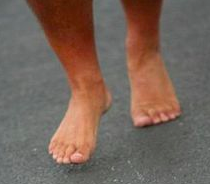
Have you ever run barefoot? Maybe it feels good or maybe you think it is bad on your feet, legs and back? Well some recent research that Chicago Chiropractic found is that the most recent innovation in athletic shoes (at least among a small but growing community of hardcore running enthusiasts) is… not wearing any at all! We were surprised too!
You may have noticed how many shoe brands are coming out with running shoes that are lighter than ever so that it feels as if you are running barefoot! For a majority of runners either considering or actively experimenting with barefoot running, it’s not about trying to rediscover their inner caveman. Individuals are looking for ways to improve comfort, reduce wear and tear on their bodies and add years to their running lives. As a chiropractor we truly value what that means! A 2009 bestselling book called “Born to Run”, written by Christopher McDougall, evangelizes barefoot running and ties many of our species’ running-related maladies to the use of shoes. But does running barefoot actually solve the problem? And do the obvious risks outweigh the potential benefits?
Lets Take a Look as to what Science Says:
The idea is controversial among medical researchers and healthcare providers as well as among runners themselves. At the center of the debate is our understanding of the musculoskeletal system and the biomechanics of running, and it’s fair to say that the evidence today doesn’t point clearly in one direction or the other. In fact, the leading researchers on the topic at Harvard University’s Skeletal Biology Lab are careful to point out that none of the information they present is meant to answer questions about how people should run and whether running barefoot or with shoes is any more likely to cause(or prevent) any particular type of injury. So if you’re thinking about adopting the barefoot running lifestyle yourself, it’s worth considering a handful of points about which there seems to be some general agreement:
1. We run much differently when we wear shoes. For example, long-time shoe wearers (that’s most Americans) tend to take longer strides and land further back on the foot, producing a harder heel strike that would be uncomfortable or painful without shoes. Shoe wearers also generally lean forward more. By contrast, experienced barefoot runners are far more likely to have a forefoot or midfoot strike and will tend to run in a more upright position.
2. The differences in running style mean that impacts and stresses are distributed and absorbed differently by the body. Research suggests that the hard heel strike creates a higher-frequency impact that tends to move upward through a runner’s bones, while the lower-frequency impact of landing on the forefoot travels through the muscles and soft tissue.
3. The fact that most Americans wear shoes from an early age means that our bodies adapt to it. And we probably adapt in a couple of different ways. Not only do we learn to move differently when we have shoes to absorb the impact and protect us from cuts and scrapes, we also strengthen (or weaken) different parts of our bodies in the process. If you’ve “grown up” running in modern athletic shoes (which enable long strides and hard heel strikes), it’s unlikely that your feet and calves have the same muscle strength as a those of an experienced barefoot runner. It’s also unlikely that you have the same sorts of calluses.
4. Just because we’ve walked and run in shoes for most of our lives doesn’t mean we can’t do something different, but it does mean that we should be smart about making a change. The last thing you want to do is to inadvertently increase the risk of some types of injury in the course of trying to prevent others. It takes time for a runner to adjust his or her form and for the body to make its own adjustments. For this reason, it’s important to make a gradual change and pay close attention to your running technique. Your own body will provide some feedback on your progress, but education and common sense should play a central role in helping you set appropriate goals and expectations. For any advice you might need you can always ask a chiropractor.
5. Whether you choose to run in shoes or to run barefoot, good form matters. And it matters a lot. We often receive patients who come to us and one of the things we try to stress as a chiropractic physician is the form your body is in during your workout. Countless coaches and trainers have gone on the record saying that bad form contributes to more running-related injuries than any other single factor. Dr. Daniel Lieberman recently provided a wonderful quote to Gretchen Reynolds of the New York Times:
“Humans may have been built to run barefoot, but we did not evolve to run barefoot with bad form.”
If you’re a runner looking for a healthier approach–especially if you are experiencing pain or have a history of injury, your chiropractic physician can help! As experts in diagnosing, treating (and, even better, preventing) muscular and skeletal problems, chiropractors use a variety of proven techniques to relieve pain, promote healing and improve performance. Best of all, they can help keep you running at your best! Call our Chicago Chiropractic office today to make an appointment at (312) 337-4004.
